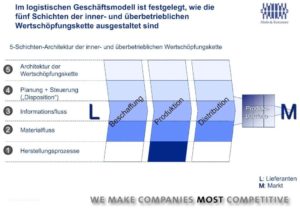Logistical business model
Every company has a corporate business model. However, few companies are aware that they also have a logistics business model (logGM). While the corporate business model is at the center of every strategic consideration, the logGM has usually grown organically and is often inconsistent, as it has emerged from different divisional perspectives.
The log GM defines which logistical value proposition is made to the market, how this value proposition can be delivered and how the logistical value proposition is to be used to generate revenue.

In many trading and production companies, the logistical value proposition is part of the product feature in that the product is offered to the market with a certain delivery readiness and delivery time. The revenue for this logistical service promise is generated via the product price, which includes the costs of providing the service. Amazon’s logGM is somewhat different. A certain basic logistical service is included in the product price. In addition, customers are offered increased logistical benefits in the form of faster delivery. The provision of this additional logistical benefit is charged separately in the form of a Prime membership, although the additional expense for the logistical provision of the service tw. will hardly be higher than for a “basic logistics service” that is included in the product price.
The profitability of the logistics business model results from the price that can be achieved on the market for the logistics value proposition, minus the costs of providing the logistics service. The aim is therefore to achieve the highest possible and most consistent logistics performance promise with the lowest possible total costs.
The costs and effort involved in providing logistics services are determined by
- The logistical structure of the product portfolio offered (ABC/XYZ/STU/WMQ distribution),
- the production facilities and manual workstations used,
- the material flow that connects the workstations,
- the information flow that controls the material flow,
- the value stream from processing and storage stages and
- the planning and control model with which the material flow is “pumped” through the value stream.
In many companies, the logistics value proposition is only very vaguely defined and this unclear goal is often only achieved with a great deal of internal friction because there is no clear logistics positioning within the value chain.
Our tip:
Work out clearly what your logistics value proposition should be and how you want to be financially compensated by the market. If the market pays you less for your logistics services than they cost, either directly or indirectly via the product price, you must first check to what extent you can improve the efficiency of your service provision. If you do not succeed in this sufficiently, then your logGM will slow down your corporate business model and you will have no choice but to align the corporate business model with the possibilities of the logistics business model.


